When compare Hestan vs Made In, they’re choosing between two cookware brands that share surface similarities — stainless steel, multi-ply, professional appeal — but diverge radically in heritage, engineering, price, and long-term value.
- Hestan represents luxury stainless innovation: titanium-reinforced NanoBond, copper-core CopperBond, and professional-grade ProBond. It’s the cookware you’ll find in Michelin-starred kitchens and in luxury U.S. homes.
- Made In is a direct-to-consumer disruptor: 5-ply stainless, carbon steel, and non-stick pans designed to rival All-Clad at half the price. It’s built for modern American households who want pro performance without luxury premiums.
This guide cuts through the noise with a professional, lab-style analysis. We’ll cover metallurgy, heat behaviour, cooking workflows, cleaning, long-term value, and U.S. pricing. The result: a clear, practical verdict on which brand makes sense for you.
Executive Summary: Who Wins and Why
- Hestan wins on innovation, luxury design, extreme heat resistance, and surface durability. Ideal for chefs, advanced cooks, and long-term buyers who want cutting-edge performance.
- Made In wins on value, accessibility, and practical performance that satisfies 95% of cooking needs at a fraction of the cost. Ideal for U.S. households upgrading from budget cookware.
Bottom line: Buy Hestan if you’re building a forever kitchen and want the very best. Buy Made In if you’re a practical cook who values performance at the right price.
Brand Overview and Market Positioning
Hestan (Luxury U.S. Brand)
- Founded: 2015 in Napa Valley, California.
- Manufacturing: Italy.
- Flagship lines:
- NanoBond → Stainless reinforced with 14,000 titanium layers.
- CopperBond → Stainless exterior with pure copper core.
- ProBond → Brushed stainless for professional kitchens.
- Reputation: Professional chefs and serious home cooks trust Hestan for performance and durability.
Made In (Modern DTC Brand)
- Founded: 2017 in Austin, Texas.
- Manufacturing: U.S., France, and Italy (depends on SKU).
- Flagship products:
- 5-ply stainless steel cookware (comparable to All-Clad).
- Carbon steel skillets (French-style).
- Non-stick cookware (PTFE).
- Reputation: Transparent pricing, strong online presence, and affordable access to pro-level cookware.
📌 Key difference: Hestan = luxury innovation, Made In = premium value disruptor.
Materials Science: NanoBond vs 5-Ply Aluminium Core
| Feature | Hestan (NanoBond / CopperBond / ProBond) | Made In (5-Ply Stainless) |
|---|---|---|
| Core material | Stainless with titanium (NanoBond) or copper (CopperBond) | Stainless with aluminium core |
| Ply count | 3–5 depending on line | 5 full layers throughout |
| Heat conductivity | Excellent (copper = best) | Very good (aluminium) |
| Surface durability | NanoBond = 400% harder than stainless | Typical stainless (prone to scratches) |
| Oven safety | NanoBond up to 1050°F | Up to 800°F |
| Induction compatibility | Yes | Yes |
Key insight: Hestan’s use of titanium and copper gives it true engineering differentiation. Made In sticks to proven 5-ply aluminium, which is excellent but not cutting-edge.
Thermal Performance: Response, Retention, and Searing
Hestan
- CopperBond → unmatched responsiveness. Adjust burner → instant reaction. Ideal for sauces, reductions, and searing steakhouse-quality crusts.
- NanoBond → holds high heat, resists tarnish, ideal for daily searing and sautéing without cosmetic wear.
Made In
- 5-ply aluminium core distributes heat evenly.
- Excellent for frying, boiling, roasting.
- Slight lag compared to copper when making delicate sauces or caramel.
📌 Thermal difference: Both are excellent, but Hestan outperforms in pro-grade scenarios where milliseconds matter.
Everyday Cooking Tests
| Cooking Task | Hestan (NanoBond/CopperBond) | Made In (5-Ply Stainless) |
|---|---|---|
| Steak searing | Restaurant-level crust, instant control | Excellent crust, slower to adjust |
| Sauce reduction | Fast and precise, no scorching | Reliable but less responsive |
| Egg frying (with oil) | Low sticking, easy release | Good release, needs proper preheat |
| Soup/stew | Efficient, retains moderate heat | Slightly higher retention |
| Induction performance | High efficiency, no warping | Strong, slower response |
Maintenance and Long-Term Wear
Hestan
- NanoBond → dishwasher safe, resists tarnish, keeps mirror finish.
- CopperBond → interior easy to maintain; copper exterior requires polish.
- ProBond → brushed finish hides scratches.
Made In
- Dishwasher safe but prone to staining.
- Requires Bar Keepers Friend or citric acid to restore shine.
- Handles riveted; durable but less polished finish.
📌 Maintenance split: Hestan = luxury low-maintenance. Made In = traditional stainless upkeep.
Price and Lifetime Cost Calculations
| Product / Set | Hestan (Avg U.S. Price) | Made In (Avg U.S. Price) |
|---|---|---|
| 10” Fry Pan | $220–$300 | $99–$129 |
| 3 qt Saucepan | $300–$400 | $129–$169 |
| 10-Piece Set | $1,499–$2,499 | $699–$899 |
Cost per year (conservative estimates):
- Hestan ($2,000 ÷ 20 years) = $100/year.
- Made In ($800 ÷ 10 years) = $80/year.
If Made In lasts 15 years, it drops to ~$53/year. If Hestan lasts 25 years, it drops to ~$80/year.
📌 Economic insight: Both deliver value, but Hestan’s premium comes from innovation and durability, while Made In maximizes performance per dollar.
Buyer Profiles and Scenarios
- Buy Hestan if:
- You’re a chef or advanced home cook.
- You want precision, responsiveness, and a tarnish-proof finish.
- You plan to keep cookware for decades.
- Your budget allows luxury investment.
- Buy Made In if:
- You’re upgrading from budget sets (T-fal, Cuisinart, Amazon basics).
- You want pro-level stainless without luxury pricing.
- You’re a younger U.S. household or apartment cook.
- You want to build a full set affordably.
FAQs
Is Hestan worth the premium over Made In?
Yes, if you value surface durability, extreme heat resistance, and precision copper-core responsiveness.
Is Made In better than All-Clad?
Made In competes with All-Clad D3/D5 in thermal performance, often at 30–40% less cost.
Does NanoBond really resist scratches?
NanoBond holds up better than traditional stainless but isn’t indestructible. Metal tools won’t scar it as easily.
Which is better for induction?
Both brands perform well; Hestan’s heavier bases make it slightly more stable.
Can I use metal utensils?
Hestan NanoBond tolerates them better cosmetically. Made In can scratch more visibly.
Final Comparison Table
| Feature | Hestan | Made In |
|---|---|---|
| Founded | 2015, Napa Valley, CA | 2017, Austin, TX |
| Manufacturing | Italy | U.S., France, Italy, China |
| Core material | Stainless + titanium or copper | Stainless + aluminium |
| Heat responsiveness | Exceptional | Very good |
| Durability | 20+ years, tarnish resistant | 10–15 years, staining possible |
| Oven safety | Up to 1050°F (NanoBond) | Up to 800°F |
| 10-pc set cost | $1,499–$2,499 | $699–$899 |
| Best for | Luxury, pro-level cooking | Affordable premium home cooking |
Professional Verdict
- Hestan is best for: U.S. buyers who want luxury cookware that will perform at the very highest levels — sauces, searing, induction, oven. It’s for the cook who treats cookware as an investment.
- Made In is best for: buyers who want 90% of that performance at 40% of the cost, especially practical households upgrading from budget stainless.
📌 Final call: Hestan = long-term luxury. Made In = smart, modern value.
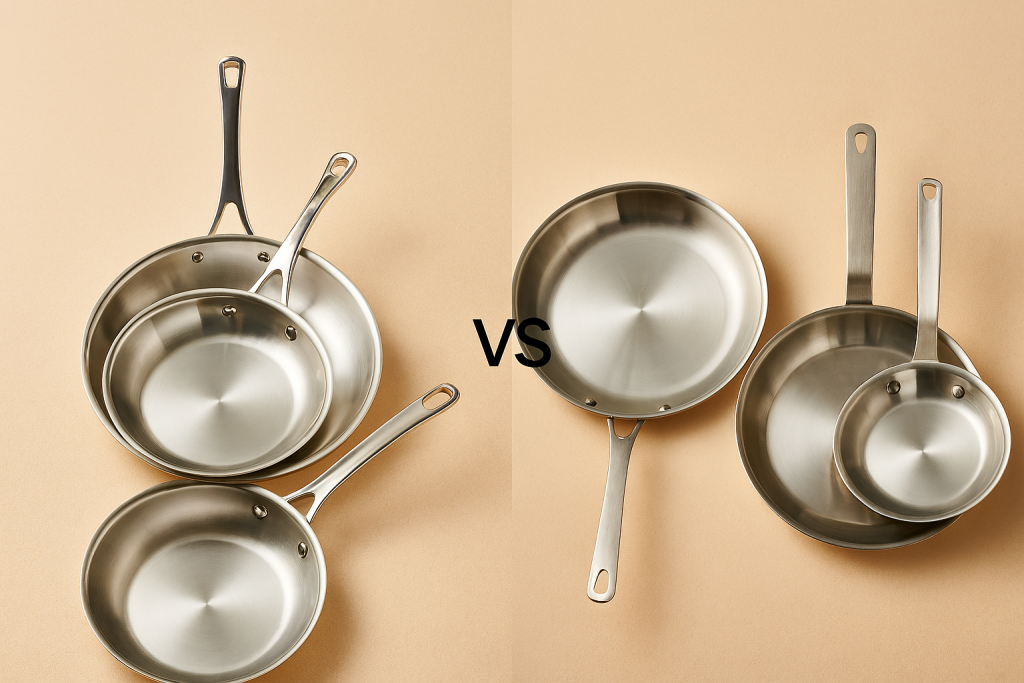

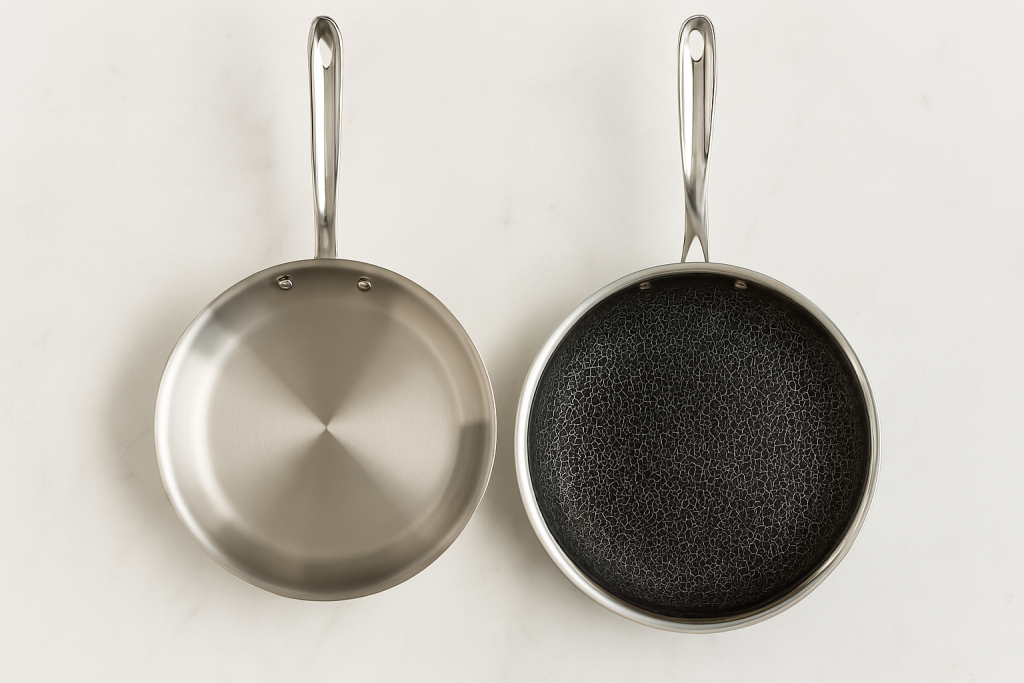
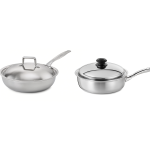
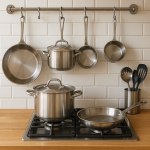
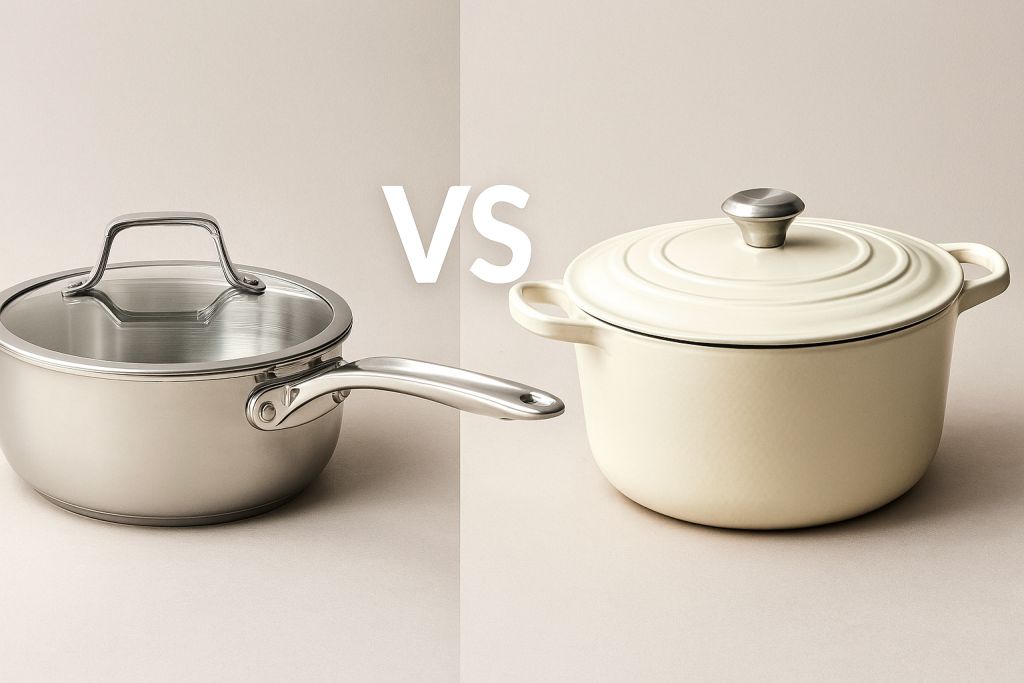

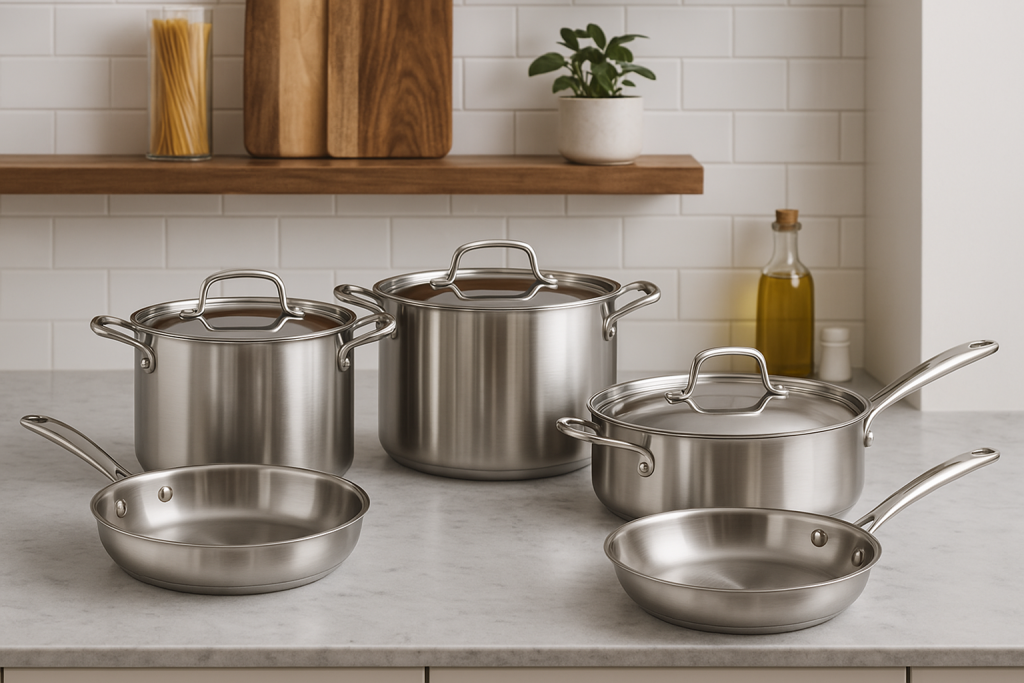



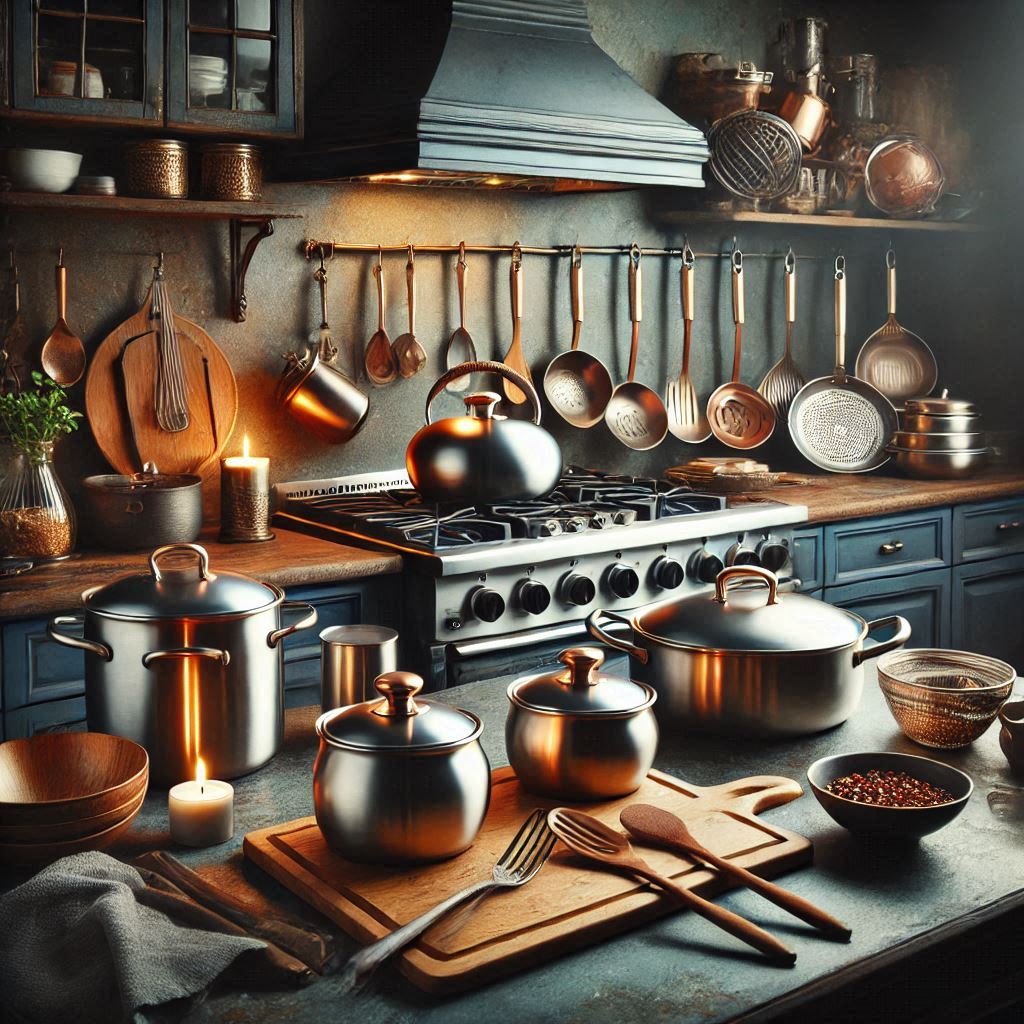
Leave a Reply